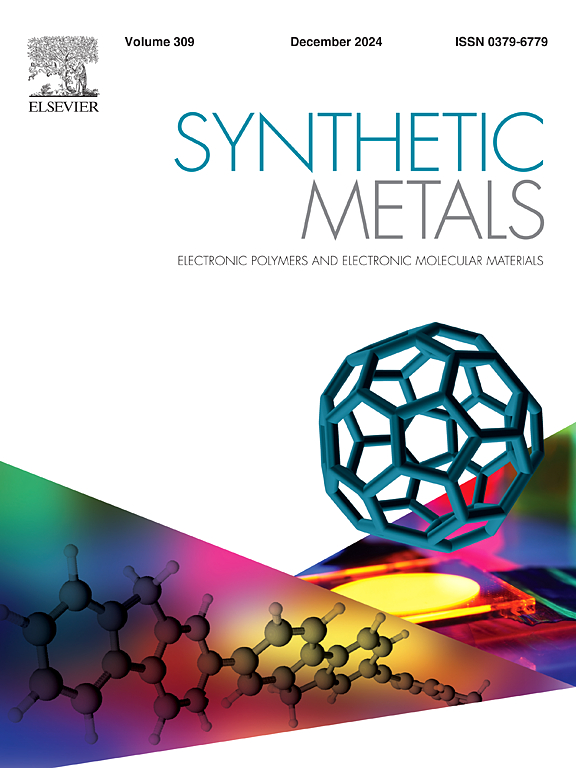苯并二噻吩上不同芳香侧基对有机太阳能电池光学、电子和光电性能的影响
IF 4.6
3区 材料科学
Q2 MATERIALS SCIENCE, MULTIDISCIPLINARY
引用次数: 0
摘要
本研究探讨了有机太阳能电池(OSC)中不同芳香侧基对施主-受体共轭聚合物中2d -苯并二噻吩(BDT)单元的影响。采用Stille交叉偶联反应合成了3种新的聚合物P1、P2和P3,它们分别在2D-BDT主链上具有苯基、噻吩基和噻吩基侧链。苯并三唑(BTz)作为电子受体,通过硒烯π桥增强电子相互作用。P1、P2和P3的光带隙分别为1.79 eV、1.74 eV和1.73 eV。以这些聚合物和PC71BM为受体制备的OSCs对噻吩取代聚合物(P2)表现出最好的性能,PCE为4.34 %,JSC为10.08 mA/cm2, VOC为0.67 V, FF为64 %。与P1和P3相比,p2基共混物与PC71BM形成了更明确的互穿网络,由于其活性层更薄,形貌优化,增强了电荷传输,促进了激子解离。这些发现强调了侧链工程在改善OSCs光电性能、形貌和光伏性能方面的重要性。本研究强调了侧链工程在调整OSCs光电特性,形态和性能方面的关键作用。研究结果强调,P2中的噻吩基侧链有助于更好的π -π堆叠和分子组织,从而与苯基和噻吩基取代的对应物相比,具有优越的器件性能。本文章由计算机程序翻译,如有差异,请以英文原文为准。
Impact of different aromatic side units on benzodithiophene on the optical, electronic, and photovoltaic properties for organic solar cell applications
This study investigates the influence of different aromatic side groups on the 2D-benzodithiophene (BDT) unit in donor–acceptor conjugated polymers for organic solar cell (OSC) applications. Three new polymers, P1, P2, and P3, featuring phenyl, thienyl, and thienothienyl side chains on the 2D-BDT backbone, respectively, were synthesized using the Stille cross-coupling reaction. The benzotriazole (BTz) unit served as the electron acceptor with a selenophene π-bridge to enhance electronic interactions. The optical band gaps were determined to be 1.79 eV, 1.74 eV, and 1.73 eV for P1, P2, and P3, respectively. OSCs fabricated using these polymers and PC71BM as the acceptor showed the best performance for the thienyl-substituted polymer (P2), achieving a PCE of 4.34 % with a JSC of 10.08 mA/cm2, an VOC of 0.67 V, and a FF of 64 %. Compared to P1 and P3, the P2-based blend exhibited a more defined interpenetrating network with PC71BM, enhancing charge transport and promoting exciton dissociation due to its thinner active layer and optimized morphology. These findings highlight the importance of side-chain engineering in improving the optoelectronic properties, morphology, and photovoltaic performance of OSCs. This study highlights the critical role of side-chain engineering in tuning the optoelectronic properties, morphology, and performance of OSCs. The findings emphasize that thienyl side chains in P2 facilitate better π–π stacking and molecular organization, resulting in superior device performance compared to phenyl and thienothienyl-substituted counterparts.
求助全文
通过发布文献求助,成功后即可免费获取论文全文。
去求助
来源期刊

Synthetic Metals
工程技术-材料科学:综合
CiteScore
8.30
自引率
4.50%
发文量
189
审稿时长
33 days
期刊介绍:
This journal is an international medium for the rapid publication of original research papers, short communications and subject reviews dealing with research on and applications of electronic polymers and electronic molecular materials including novel carbon architectures. These functional materials have the properties of metals, semiconductors or magnets and are distinguishable from elemental and alloy/binary metals, semiconductors and magnets.
 求助内容:
求助内容: 应助结果提醒方式:
应助结果提醒方式:


